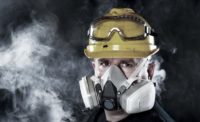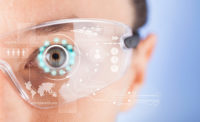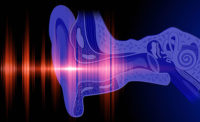Do blue light-emitting diodes (LEDs) affixed to forklifts pose an unnecessary risk? Prompted by employee concerns, a client asked me this question. Choose your answer now, and see if it wavers or changes as you progress through this article.
The purpose of blue, and sometimes red, LEDs attached to forklifts is to project focused light onto the floor at various distances front/back/side from the forklift to provide a visual warning to pedestrians and nearby workers. This practice is not required, or prohibited, by federal OSHA.
Background
Blue LEDs on forklifts appeared in the U.S. about 2013. Blue laser outdoor displays were highly marketed by QVC and retail dealers during the 2015 Christmas season. My wife bought some. Blue light sources will continue to find their way into many, many products.
OHS pros, particularly classically trained IHs, have known for decades that the blue range of visible light, sandwiched between UV and IR, within the electromagnetic spectrum, is particularly biologically active and may cause photochemical damage to the eye’s retina, interfere with things such as people’s circadian (sleep-cycle) system and produce other negative effects. IHs are also aware that “blue light” is a portion of all visible light.
On June 14, 2016, the American Medical Association issued warnings on the harmful effects, including obesity, of blue light sources, particularly high-intensity LED street lamps1. The AMA report brought prompt, opposing responses from organizations such as the Lighting Research Center2.
The AIHA issued a reference guide on blue light hazards in 20123. The DOE issued a fact-sheet on Optical Safety of LEDs in June 20134. The ACGIH issued a 2018 “Notice of Intended Change” for TLVs to include Appendix A, “statement on occupational health aspects of new lighting technologies,” to describe circadian, neuroendocrine and neurobehavioral effects of light.
The pros and cons of blue light sources, science and pseudo-science, facts and fake news, are now being waged over the Internet, where most people go to learn about such things. My client’s “employee concerns” were undoubtedly prompted by one or more employees reading, or being informed, about blue light hazards on the Internet.
Risk science and communication
Let’s go back to the original question: Do blue light-emitting diodes (LEDs) affixed to forklifts pose an unnecessary risk? The answer, unfortunately, depends on who answers the question. Even the staunchest blue light supporters agree there’s some risk, but how much?
Risk science is fuzzy. Risk depends on many things including a person’s understanding of science; a person’s current understanding of the science topic, ACGIH TLVs 2018 notice of intended change, for example; how believable the “expert” is that communicates risk; and, most importantly, what audience is receiving the risk communication, high or low IQ, for example? Risk communication includes numerous and varied context, including dreaded politics, necessary to know how the answer must be framed.
Advice
Here are six suggestions to help best answer the original question:
- Non-bias. Start your review of the topic from a neutral frame-of-mind. Don’t predispose what the answer is before a thorough review is complete.
- Apply varied Internet search terms e.g. both pro and con on the topic, to gather as many points-of-views as practical. Include authoritative sources e.g. government; organizational assessments e.g. AMA, AIHA, ACGIH, etc.; product provider e.g. LED sales, manufacturer, or distributor; and, general author assessments. This article, for example, is a general author assessment.
- Contact pros and trusted sources to obtain their input.
- Weigh the science, not the scientist’s credentials. Some people with high credentials, PhD, for example, challenged the AMA e.g. MDs on LED blue light health effects and conclusions.
- Distinguish need for compliance i.e. what regulations say must be done, versus conformance i.e. what’s the right thing to do. The “right thing to do” may vary among organizations based on risk tolerance.
- Provide a plain-English, preferably short e.g. one-page, including recommendations, risk assessment for management decisions. Senior management has the right, and you need to support, seeming dumb management decisions, that should be rare.
Non-ionizing energies
Hazard and risk assessments, including measurements where necessary, are often downplayed because of perceived technical complexities for non-ionizing electromagnetic energies that include, but not limited to, UV (solar), IR (welding), hot surfaces, visible light, laser (scanner), microwave, and with growing use, blue light LEDs.
Avoid conflict
People fear things most that they understand least. This curiosity gap fosters concerns and complaints that if not managed lead to controversy and lastly, uncontrolled, conflict. Conflict normally requires outside parties, such as OSHA, to help resolve.
The best way to avoid conflict is to properly address curiosity and concerns as soon as they arise. This may be accomplished during informal Q&A e.g. small talk on the floor; or, if necessary, during a formal training class. The point is to satisfy curiosity first.
My answer
If you apply DOE’s “Risk Groups” (see ref. 4) mostly you should find that risk is negligible, provided no one gives a fixed stare directly into the LED lens from about eight-inch distance. Glare, that may briefly result from highly reflective surfaces, is not expected to be a heightened risk due to humans’ natural aversion response -- the blink reflex.
Like most “experts” however, my answer is hedged with the caveat that each workplace is unique and specific hazard and risk assessments must be unique.
Its best if the person(s) that conduct assessments have STEM education supported by continued awareness and learning. As noted in advice #5, give preference to the science more than a person’s
credentials.
References:
- https://www.ama-assn.org/ama-adopts-guidance-reduce-harm-high-intensity-street-lights
- http://www.lrc.rpi.edu/resources/newsroom/AMA.pdf
- https://www.aiha.org/get-involved/VolunteerGroups/Documents/NONIONRAD-BlueLightquickreferenceguideDec2012.pdf
- https://www1.eere.energy.gov/buildings/publications/pdfs/ssl/opticalsafety_fact-sheet.pdf




